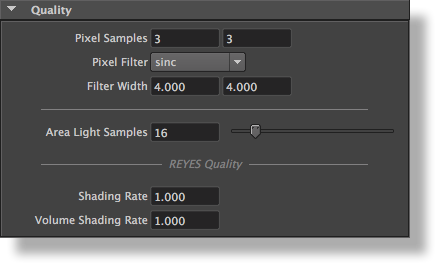Overview
The attributes in the Quality group control several parameters affecting the quality of the rendering. The default values should provide a normal, draft quality, render.
The Quality group
Pixel Samples
This option specifies in how many sub-samples each pixel will be subdivided. A draft quality setting for this parameter is 4x4 and a higher quality setting could be 6x6. Higher values might be needed if motion blur or depth of field are to be rendered. The default value is 3x3.
Pixel Filter
The name of the filter that is used to re-sample the sub-samples. Available values are: ‘box’, ‘triangle’, ‘gaussian’, ‘catmull-rom’, ‘bessel’, ‘sinc’, ‘mitchell’, ‘zmin’ and ‘zmax’. ‘catmull-rom’ and ‘sinc’ filters are common in production work. It should be noted that there is no additional performance cost for using more “complicated” filters instead of simpler ones (such as the ‘box’ filter). The default value is ‘sinc’.
Filter Width
Specifies how many pixels the filter will cover. The larger the value the slower is the filtering process. Note that enlarging some filters, such as the ‘gaussian’ or ‘box’ will blur the result and not increase the quality. Additionally, some filters do not work well with small width values. This is the case of the ‘sinc’ filter for which it is not suggested to specify values less than 4x4, which is the default value.
REYES Quality
Shading Rate
Controls how finely the geometry is tessellated prior to shading. 3delight adaptively tessellates each primitive into very tiny elements called micro-polygons, those ele- ments are then shaded and sampled. Usually, the size of one such micro-polygon is one screen pixel and this corresponds to a shading rate of 1.0. A shading rate of 4.0 will produce micro-polygons that cover approximately an area of 2x2 pixels and a shading rate of 0.5 will give two micro-polygons per pixel. It is recommended to leave this parameter to its default value of 1.0 and reasons why not doing so are explained in Chapter 5 [Rendering Guidelines], page 105.
Volume Shading Rate
This options controls the frequency of shading for interior shaders. It also applies to atmosphere shaders and to Maya fluids. This setting behaves in a similar fashion to Shading Rate, but its effect is limited to volume shaders. The default volume shading rate is 1.0.
